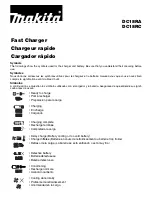
Original Language Version
© Jack Sealey Limited
SPI13S Issue: 1 - 21/05/14
5. CONTROL PANEL
4.8.
Charger Location
WARNING!
RISK OF EXPLOSION AND CONTACT WITH BATTERY ACID.
4.8.1.
Locate the charger as far away from the battery as the DC cables permit.
4.8.2.
Never place the charger directly above the battery being charged; gases from the battery will corrode and damage the charger.
4.8.3.
DO NOT
set the battery on top of the charger.
4.8.4.
Never allow battery acid to drip onto the charger when reading the electrolyte specific gravity or filling the battery.
4.9.
Follow these instructions when the battery is installed in a vehicle.
WARNING! A SPARK NEAR THE BATTERY MAY CAUSE A BATTERY EXPLOSION. REDUCE THE RISK OF A SPARK NEAR
THE BATTERY:
4.9.1. Position the mains and DC cables to reduce the risk of damage by the bonnet, door and moving or hot engine parts.
NOTE:
If it is
necessary to close the bonnet during the charging process, ensure that the bonnet does not touch the metal part of the battery clips or
cut the insulation of the cables.
4.9.2. Stay clear of fan blades, belts, pulleys and other parts that can cause injury.
4.9.3. Check the polarity of the battery posts. The POSITIVE (POS, P, +) battery post usually has a larger diameter than the NEGATIVE (NEG,
N, -) post.
4.9.4. Determine which post of the battery is earthed (connected) to the chassis. The battery terminal not connected to the chassis has to be
connected first. The other connection is to be made to the chassis, remote from the battery and fuel line. The battery charger is then to
be connected to the mains. See sections 4.9.5. and 4.9.6
4.9.5. For a negative-earthed vehicle, connect the POSITIVE (RED) clip from the battery charger to the POSITIVE (POS, P, +) non earthed
post of the battery. Connect the NEGATIVE (BLACK) clip to the vehicle chassis or engine block away from the battery.
DO NOT
connect
the clip to the carburettor, fuel lines or sheet-metal body parts. Connect to a heavy gauge metal part of the frame or engine block.
4.9.6. For a positive-earthed vehicle, connect the NEGATIVE (BLACK) clip from the battery charger to the NEGATIVE (NEG, N, -) non
earthed post of the battery. Connect the POSITIVE (RED) clip to the vehicle chassis or engine block away from the battery.
DO
NOT
connect the clip to the carburettor, fuel lines or sheet-metal body parts. Connect to a heavy gauge metal part of the chassis or engine
block.
4.9.7.
Connect charger mains cable to electrical outlet.
4.9.8. After charging, disconnect the battery charger from the mains. Then remove the chassis connection and then the battery connection.
4.10. Follow these steps when the battery is outside the vehicle.
WARNING! A SPARK NEAR THE BATTERY MAY CAUSE A BATTERY EXPLOSION. REDUCE THE RISK OF A SPARK NEAR
THE BATTERY
4.10.1. Check the polarity of the battery posts. The POSITIVE (POS, P, +) battery post usually has a larger diameter than the NEGATIVE
NEG, N, -) post.
4.10.2. Attach at least a 24-inch (61 cm) long 6-gauge (AWG) insulated battery cable to the NEGATIVE (NEG, N, -) battery post.
4.10.3. Connect the POSITIVE (RED) charger clip to the POSITIVE (POS, P, +) post of the battery.
4.10.4. Position yourself and the free end of the cable you previously attached to the NEGATIVE (NEG, N, -) battery post as far away from the
battery as possible – then connect the NEGATIVE (BLACK) charger clip to the free end of the cable.
4.10.5.
DO NOT
face the battery when making the final connection.
4.10.6. Connect charger mains cable to an electrical outlet.
4.10.7. When disconnecting the charger, always do so in the reverse order of the connecting procedure and break the first connection while
as far away from the battery as practical.
4.10.8. A marine (boat) battery must be removed and charged on shore. To charge it onboard requires equipment specially designed for
marine use.
1. Mains cable
2. Digital display
3. Battery type button
4. LED indicator
5. Hook attachment
(on back)
6. Battery clamps
(Quick connect)
7. Ring terminals
(Quick connect)
fig.1
























